SaaS Statistics By Size, Share and Companies
Page Contents
- Introduction
- Editor’s Choice
- What is SaaS?
- Categories of SaaS and Examples
- General SaaS Statistics
- SaaS Market Projections 2026-2030: Valuations Across Industries
- SaaS Statistics by Pricing Statistics
- SaaS Statistics by Reasons for Adoption
- SaaS Statistics by Total Companies
- SaaS Statistics by Popular Development Language
- SaaS Statistics by Concerns With Public Cloud
- SaaS Statistics by Importance
- SaaS Statistics by Total Revenue Generated in Top Countries
- SaaS Statistics by The Distribution of Public Cloud
- SaaS Statistics by Industries
- July 2023: Top 10 SaaS Companies by Market Cap
- Conclusion
Introduction
SaaS Statistics: The technological developments are bringing the world closer. SaaS-like companies are making it possible. From starting a business to managing it, has become so much easier. SaaS / Software as a Service has spread its applications to a number of industries. These can also create customized projects as per the requirements of the businesses. Together with SaaS, LaaS, and PaaS what has not been ever possible? These are not only limited to one industry but in general as well. The insights in these SaaS Statistics will focus on the SaaS market only.
Editor’s Choice
- SaaS Statistics observed that by 2027 companies that are using software as a service products will centralise their management.
- By 2027, the SaaS-based global retail and e-commerce market is expected to reach $138.9 billion.
- As of today, there are more than 23,000 SaaS companies around the world that are providing exceptional services to their customers.
- Most users of SaaS applications belong to the IT departments, Engineering, and security.
- 38% of the SaaS companies offer billing on usage of the software, while 84% offer pricing from low to high.
- The biggest concern laid out by organizations that are using public cloud is security resulting in 66%.
- Comparing the global number of SaaS companies, the United States of America has 8 times more of those than other countries., furthermore The SaaS industry is expected to double its growth by 2025.
- Software as a service companies that offer a great mobile responsive User interface have experienced a 30% more user engagement rate.
- In the next 12 months, companies around the world are planning to increase their spending on SaaS applications by 78%.
- By 2026, SaaS Statistics states that the global SaaS customer relationship management (CRM) system market is expected to reach $44.6 billion by 2026.
What is SaaS?
Software as a Service (SaaS) is a developed technology or approach that is application-based and is useful in improving business processes. SaaS is usually hosted on cloud-based technologies and, therefore can be easily accessed from any location. In a rapidly growing world, these SaaS products are working as a game changer. From punching employee attendance to exceptional customer services as well as other businesses operations are handled by such applications. The development of SaaS products is bringing the world together, and making it possible for employees to work remotely as well. Some of the features of SaaS products include
- Automated Systems
- Single Sign-on options
- Multi-tenancy model
- Flexible structure
- Improved performance
- Subscription-based billing
- High-End data security
- Worldwide availability
- Easy Audits
- Easy SaaS application customizations
- Effective integrated APIs as well as integration protocols
Categories of SaaS and Examples
- Customer Relationship Management (CRM) – Salesforce, HubSpot, Microsoft Dynamic 365, Oracle etc
- HR/ HRM Solutions Software – Rippling, Paycor, Trinet, Conncteam, Dell, etc
- e-Commerce and CMS platforms software – BigCommerce, Shopify, WordPress, Sitecore, Drupal, etc
- Project Management Software – Wrike, Smartsheet, Notion, Basecamp etc
- Accounting Software – FreshBooks, Oracle NetSuite Accounting Software, Xero, Melio, etc
- Enterprise Resource Planning (ERP) Software – SAP ERP, Oracle Cloud Enterprise Resource Planning, ERPNext etc
- Payment Gateways and billing Solutions – Venmo, Square Payment, Stripe, etc
- Customized Software for different goals – Gaming, Streaming, Aviation, Voice Recognition, etc
General SaaS Statistics
- Free trials offered by SaaS companies generate a 15% more conversion rate as compared to those that do not.
- Companies that provide orderly product updates and enhancements are likely to achieve a 21% more customer retention rate.
- Around the world, 75% of business leaders have experienced enhanced business processes due to SaaS products.
- Moreover, it is observed that SaaS companies that provide self-service onboarding experience are likely to get a 36% higher customer renewal rate.
- On the other hand, such companies are likely to lose on average 13% of the customer for every financial year because of deficient onboarding experiences.
- Software as a service companies that offer a great mobile responsive User interface have experienced a 30% more user engagement rate.
- As of today, there are more than 23,000 SaaS companies around the world that are providing exceptional services to their customers.
- According to an IBM study, out of Fortune 1000 Companies, 1 in 3 employees are using unauthorized cloud-based SaaS applications.
- In the next 12 months, companies around the world are planning to increase their spending on SaaS applications by 78%.
- SaaS Statistics observed that by 2027 companies that are using the software as a service product will centralise their management.
- Comparing the global number of SaaS companies, the United States of America has 8 times more of those than other countries., furthermore The SaaS industry is expected to double its growth by 2025.
- By 2025, experts' predictions state that around 85% of businesses will start using SaaS-based software.
- 50% of the worldwide data will be transferred to clouds by 2025.
- On average, a company uses around 254 SaaS applications.
- As of 2023, the SaaS Industry is valued at $192.2 billion.
- Most users of SaaS applications belong to the IT departments, Engineering, and security.
- As of 2023, the most popular Software-as-a-service applications are deployed by AWS and Google Cloud.
- By 2027, almost 50% of the SaaS companies will adopt the usage-based pricing mode (UBP) while 31% will choose a hybrid pricing model.
- It is projected that the global spending on SaaS-based cloud services will reach $591.8 billion by the year-end of 2023.
- Every paid SaaS product remained unused for the initial 90 days.
- SaaS Statistics state that, as of 2023, around 38% of enterprises are running their processes completely on SaaS-based applications, whereas by the end of 2023, the count will rise to 99%.
- SaaS generated more importance because of remote work.
SaaS Market Projections 2026-2030: Valuations Across Industries
- By 2026, SaaS Statistics states that the global SaaS customer relationship management (CRM) system market is expected to reach $44.6 billion by 2026.
- Furthermore, the worldwide SaaS inclusive supply chain management (SCM) system is projected to value at $14.4 billion by 2026.
- The SaaS rooted Finance and accounting software market is expected to reach $7.4 billion in similar years.
- The worldwide market for e-learning is projected to reach $11.9 billion.
- The global Enterprise Resource Planning software (ERP) market is projected to reach $59.5 billion.
- By 2027, the SaaS-based global retail and e-commerce market is expected to reach $138.9 billion.
- By 2026, similarly, the global cloud computing market is forecast to reach $947.3 billion.
- The global video conferencing market is expected to reach $14.58 by 2029.
- Furthermore, the Healthcare SaaS-based market is expected to reach $50 billion by 2028.
- The cloud-based computing market is projected to hit $947.3 billion by 2026.
- By 2027, the banking, insurance, and financial sector is expected to reach $130.7 billion.
- By 2027 the global software as a service market itself is expected to reach $571.9 billion.
SaaS Statistics by Pricing Statistics
- 38% of the SaaS companies offer billing on usage of the software, while 84% offer pricing from low to high.
- Only 9% of companies offer from high to low.
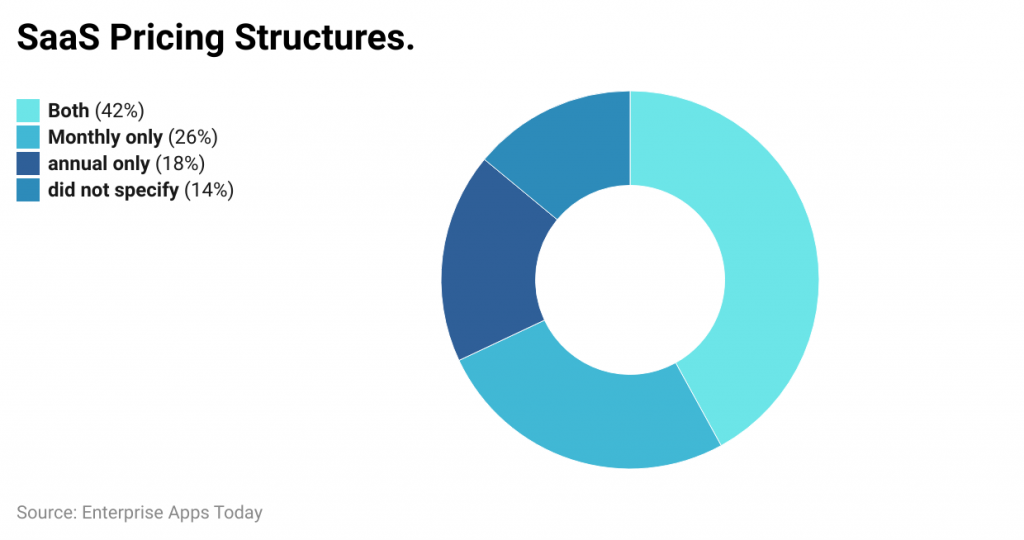 (Source: byscottkimberly.com)
(Source: byscottkimberly.com)
- Around 42% of the companies use monthly as well as annual pricing-based strategies.
- Whereas only 26% of those allow monthly pricing structures.
- 18% chose an annual structure and 14% of the SaaS-based companies did not specify any pricing structures.
By Pricing Services
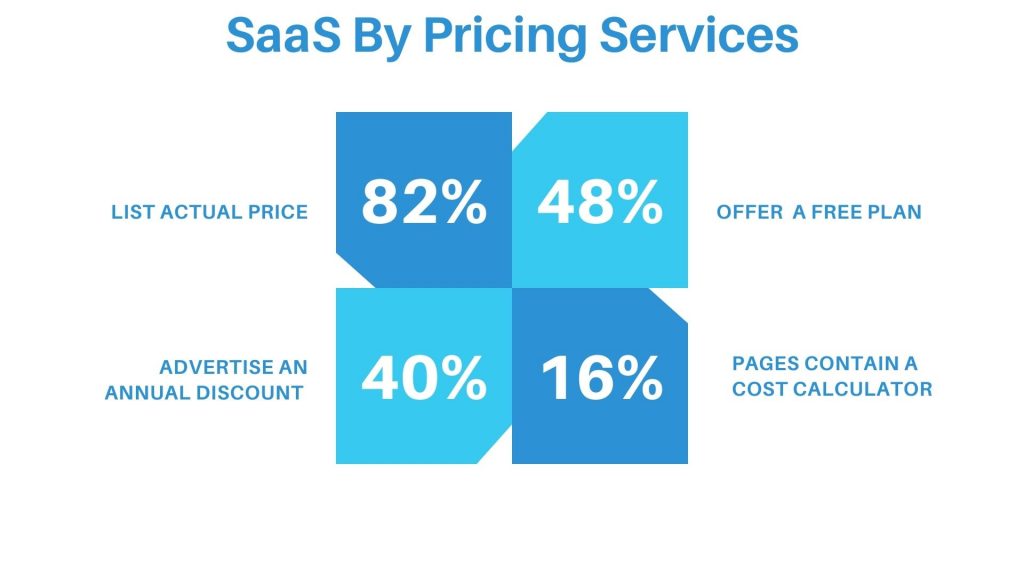 (Source: byscottkimberly.com)
(Source: byscottkimberly.com)
- SaaS Statistics state that 82% of the companies list their actual prices on their websites, while 48% offer a free plan.
- 40% of SaaS companies showcase annual discounts.
- And only 16% of the companies have a Cost Calculator on their websites.
SaaS Statistics by Reasons for Adoption
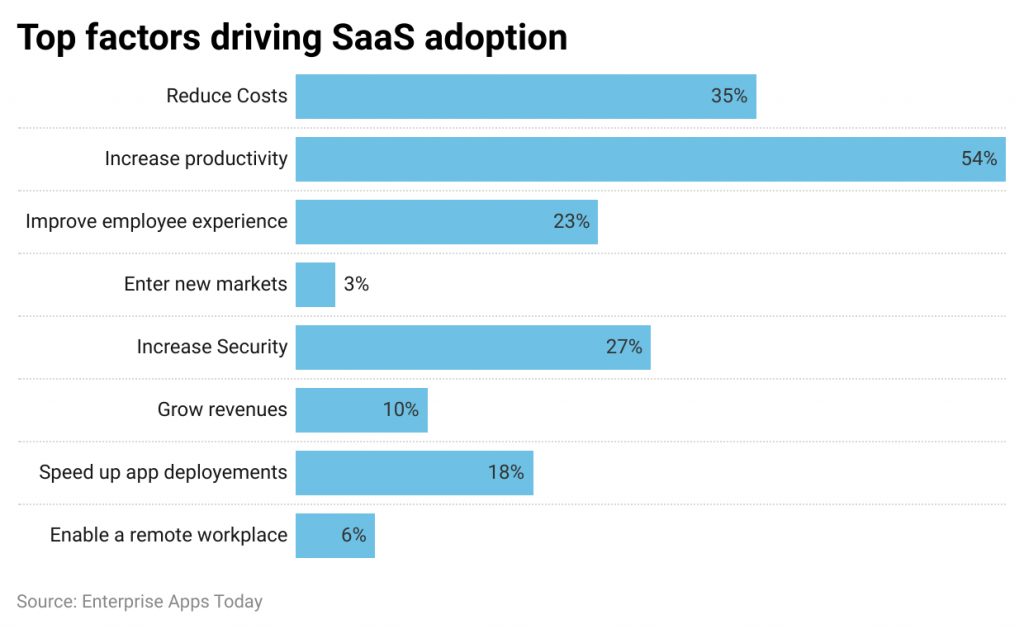 (Source: onlinesuccessgenie.com)
(Source: onlinesuccessgenie.com)
The top reason to use any SaaS Application is because it increases productivity as said by 54% of the users. Followed by 35% of the companies starting cost reduction, then Increased Security (27%), Enhanced Employee Experience (23%), Quicker app deployments (18%), Growth in revenues (10%), and enabled remote workplaces (6%).
SaaS Statistics by Total Companies
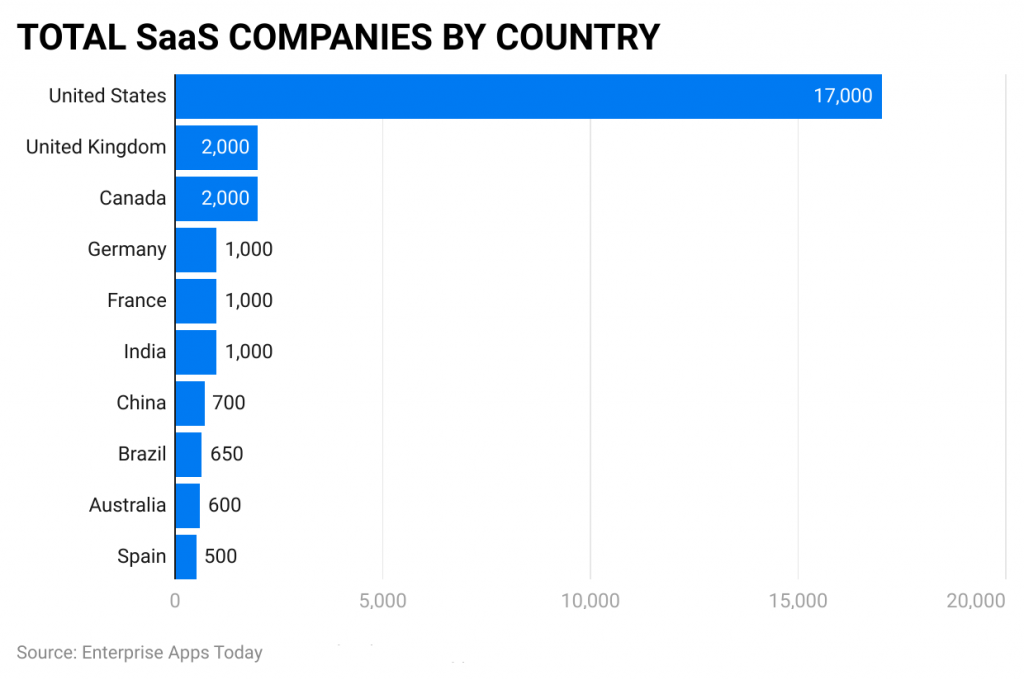 (Source: zippia.com)
(Source: zippia.com)
As of 2023, the Top 10 countries with the highest number of SaaS companies are listed respectively as
The United States of America (17,000) followed by, the United Kingdom and Canada (2,000), Germany, France, and India (1,000), China (700), Brazil (650), Australia (600), and Spain (500).
SaaS Statistics by Popular Development Language
Please include attribution to vpnAlert.com with this graphic.
The most popular development language for SaaS products is Javascript (65%), followed by HTML/CSS (56%), Python (48%) and SQL (47%).
SaaS Statistics by Concerns With Public Cloud
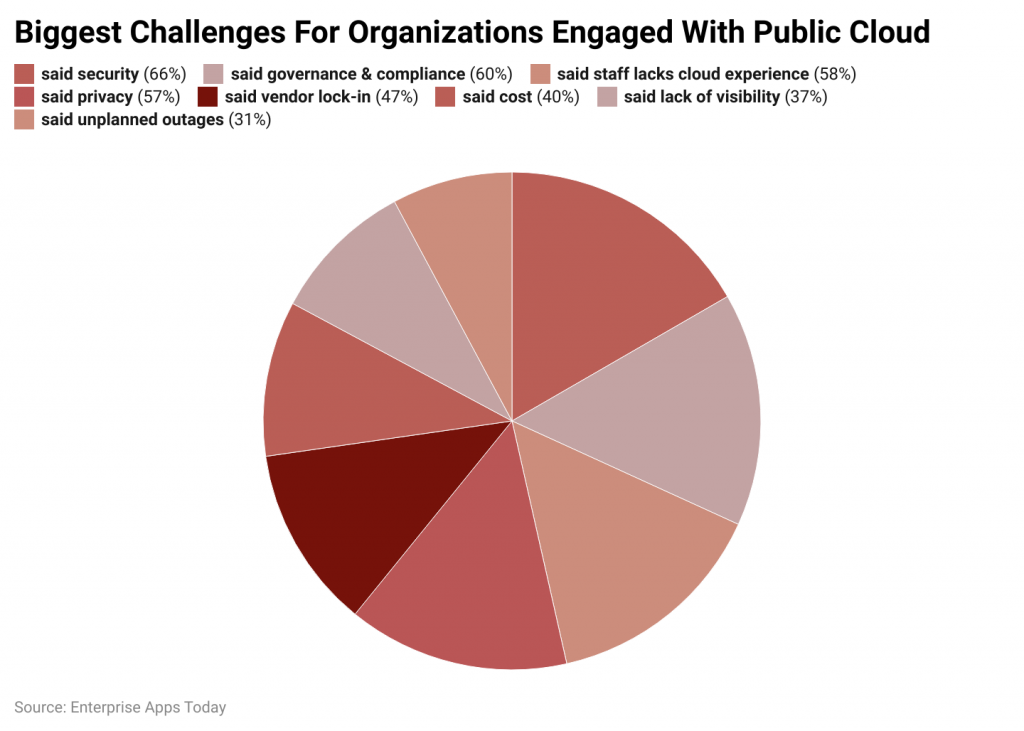 (Source: marketsplash.com)
(Source: marketsplash.com)
- The biggest concern laid out by organizations that are using public cloud is security resulting in 66%.
- Further challenges observed by companies are Governance and Compliance (60%), Staff lacking in cloud experience (58%), Privacy concerns (57%), Vendor Lock-in (47%), Cost (40%), and Lack of visibility (37%).
- The lowest concern of all was marked by 31% of the organizations stating unplanned outages.
SaaS Statistics by Importance
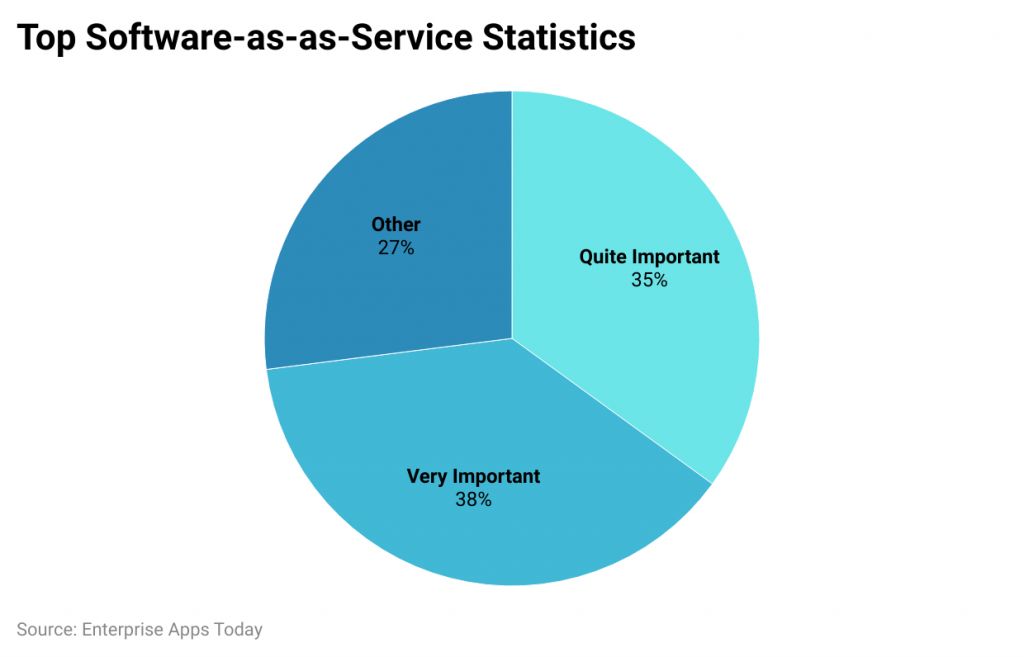 (Source: byscottkimberly.com)
(Source: byscottkimberly.com)
38% of the SaaS users said they find it very important, while 35% find it quite important and only 27% of the companies have various views on SaaS applications.
SaaS Statistics by Total Revenue Generated in Top Countries
| Top Countries | Revenue generated from SaaS companies |
|---|---|
| The United States | $401.6 billion |
| Italy | $41.5 billion |
| The United Kingdom | $26.6 billion |
| Australia | $16 billion |
| India | $15.1 billion |
| Germany | $13.8 billion |
| France | $13.1 billion |
| Canada | $13 billion |
| Germany | $13.8 billion |
| Singapore | $10.5 billion |
| Netherlands | $9.5 billion |
| South Africa | $8.2 billion |
| China | $6.6 billion |
| Hong Kong | $9.5 billion |
| Netherlands | $5.7 billion |
| Japan | $3.8 billion |
| South Korea | $3.7 billion |
(Source: demandsage.com)
The top 3 countries with the highest revenue generated from SaaS companies in 2023 are The United States of America (401.6 billion), Italy ($41.5 billion), and The United Kingdom ($26.6 billion), whereas the least revenue earners in the list are Canada ($13 billion), Singapore ($10.5 billion) and Netherlands ($9.5 billion).
SaaS Statistics by The Distribution of Public Cloud
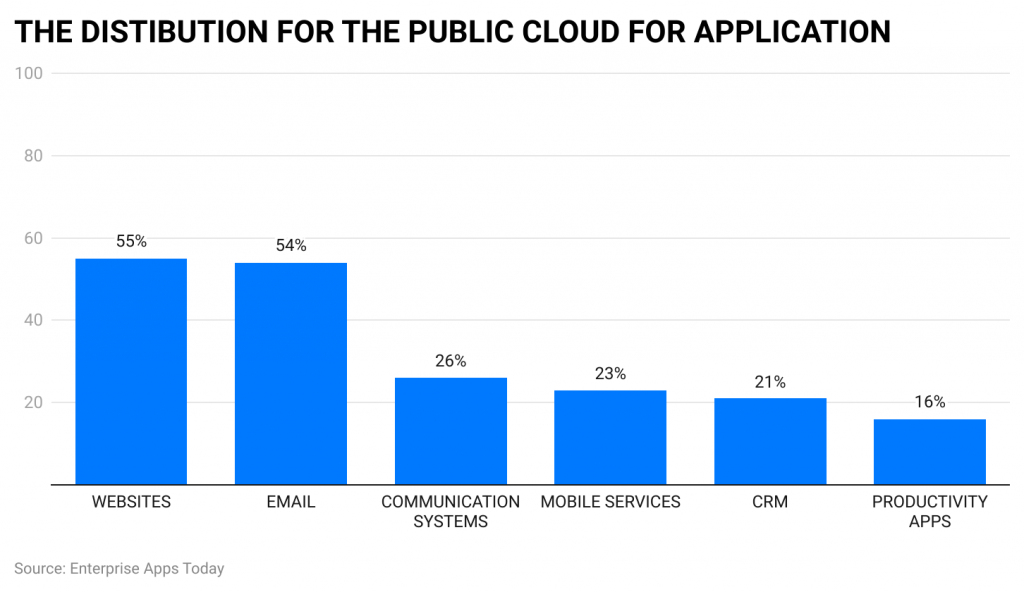 (Source: popupsmart.com)
(Source: popupsmart.com)
The top three services that are using the public cloud are Websites (55%), Email (54%), and Communication Systems (26%) followed by mobile services (23%), CRM (21%), and Productivity Apps (16%).
SaaS Statistics by Industries
The largest contribution from SaaS applications belongs to the Productivity and Collaboration industry having around 24,365 companies, with a market share of 23%. Followed by other industries as follows Customer Service – 17,035 (16%), Marketing – 14,822 (14%), e-commerce – 13,946 (13%), Data and Analytics – 12,359 (11%), Sales – 11,559 (11%), Human Resources- 8,265 (8%), and Finance – 5,453 (5%).
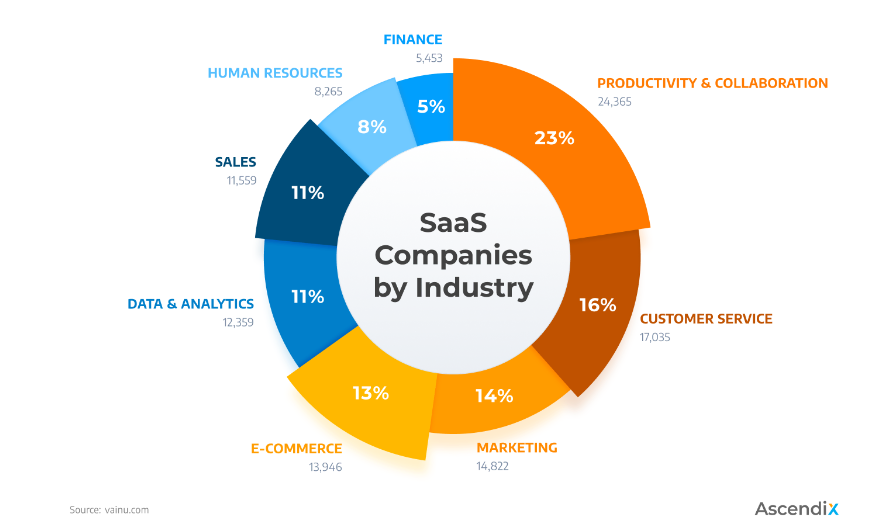 (Source: ascendixtech.com)
(Source: ascendixtech.com)
July 2023: Top 10 SaaS Companies by Market Cap
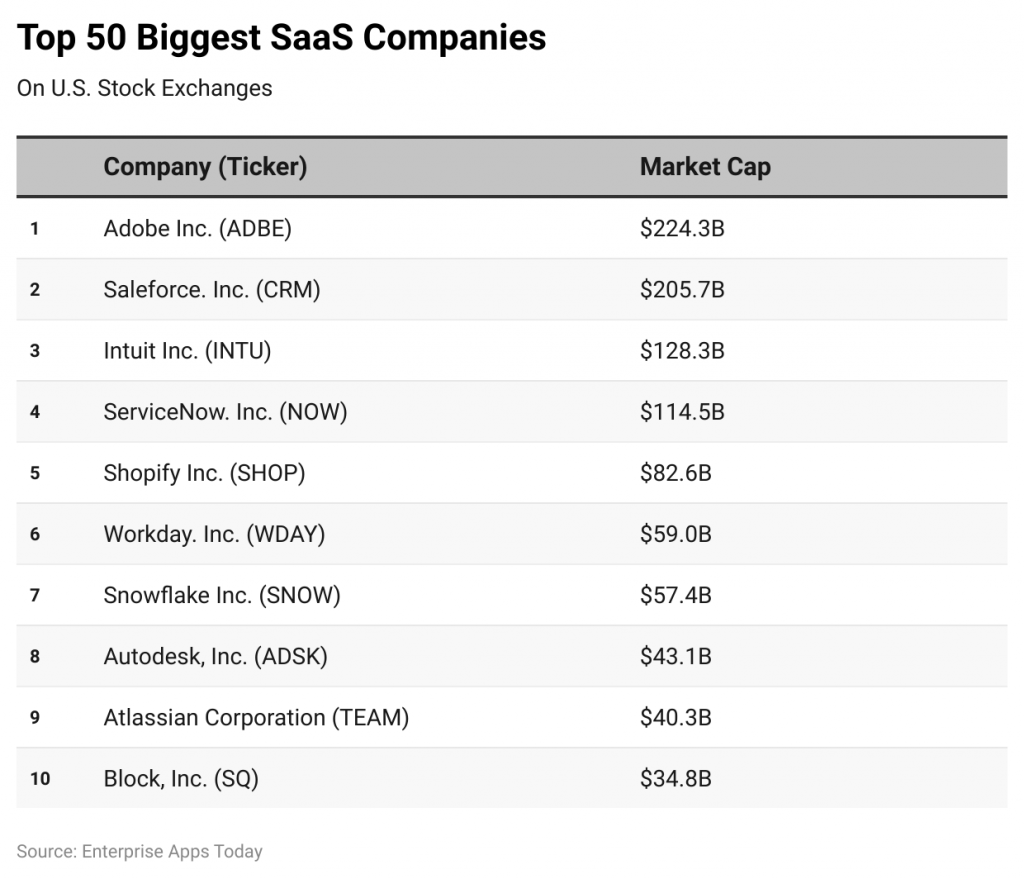 (Source: cloudzero.com)
(Source: cloudzero.com)
The top 3 SaaS companies by Market Capitalization around the world are Adobe Inc ($224.3 billion), Salesforce Inc ($205.7 billion), and Intuit Inc. ($128.3 billion). SaaS companies with the lowest market cap but yet topped the list of the top 10 in July 2023, are Autodesk, Inc. (43.7 billion), Atlassian Corporation ($43.1 billion), and Block, Inc ($40.3 billion).
Conclusion
The Software as a Service industry has become a boon to the world. Almost half of the global data has rested on the clouds. The overall functionality and ease of use have reduced all the complex hard work in every industry. It has become easy to manage millions of customers 24/7. In addition, SaaS Statistics show that it has greatly managed remote work for almost every industry. In the coming years, there will be more advancements in such applications, making them more easy and approachable to everyone.

Barry is a lover of everything technology. Figuring out how the software works and creating content to shed more light on the value it offers users is his favorite pastime. When not evaluating apps or programs, he's busy trying out new healthy recipes, doing yoga, meditating, or taking nature walks with his little one.
